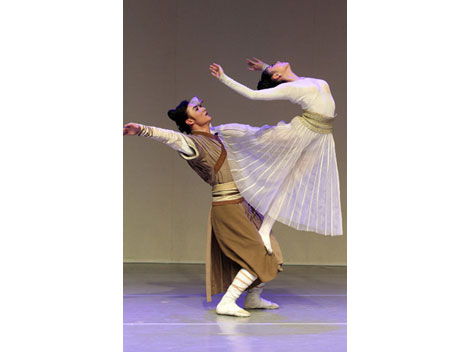
Lord of the Chinese Dance
The 52-year-old Zhang is now one of China's leading choreographers, having created more than 420 works since the mid- 1970s, including I Come From the Yellow River and Spine Dates, many of which have been staged in over 60 countries.
His most famous and successful dance, Thousand-Hand Bodhisattva, features 21 hearing-impaired dancers in stunning gold costume forming remarkable arm movements by standing behind each other in perfect symmetry. Following its performance at the Closing Ceremony for the 2004 Summer Paralympics in Athens and showing on China Central Television's 2005 Spring Festival gala, the piece won critical acclaim both at home and abroad.
Although the piece has enjoyed popularity and high praise, Zhang sought to make further breakthroughs in the new drama, which will feature a similar dance at the end of the 100-minute production.
"The dance has become so well-known with the audience and it is a tough job to arouse resonance, and differentiate it from the previous one," Zhang said.
Sticking to his principle of "not repeating others' work nor his own," he spent seven years visiting holy Buddhist venues, including the Yungang Grottoes and Jin'ge Monastery in Shanxi to research for his drama. "For choreographers, the most important thing is to see with your unique artistic taste beforehand and use various means to differentiate your [new] works from your others," Zhang added.
Deity's duet
Instead of dividing the drama into acts and scenes like most, the director has set Thousand-Hand Bodhisattva to 12 odes and created 12 dances, giving more freedom to follow the storyline. Each ode and dance can be viewed as a separate episode and together become one integrated story.
One of the highlights of the dances is between the princess and the servant-robber Tongzi. While most duets tend to be about communicating the feelings between two human beings, this one, between a deity and a mortal, requires the dancers to hold a far more reserved exchange.
"During the duet, when I am miming smelling the Bodhisattva, I tend not to touch her. Also, when I am moving her when she is meditating cross-legged, I behave very carefully, with reverence. All these show the character's respect for the deity," said Zhang Aoyue, playing Tongzi, who develops a liking for the princess during their journey.
"To play Bodhisattva, you have to calm yourself and become pure from inside. Although I haven't experienced the great love and benevolence of Bodhisattva, I draw it from everyday life," said Zhang Xiaochuan, who performs the Bodhisattva.
"Everyone has a kind side and can help others when they need help… You don't need to look for the quality on purpose, it is all about life."
Zhang also worked with an international team to boost quality, creating a whole new set of music, sets, lighting and costumes.
While the piece features a huge number of performers, the music tends to be simple and quiet, creating a pure, quiescent atmosphere during the production.
"Music should come from the bottom of the heart and it should not be simply a dramatic explanation of dance. It should have aesthetic values of its own and means of expression," Zhang said.
"The quality needs to be pure and the style needs to be authentic."
We Recommend:
